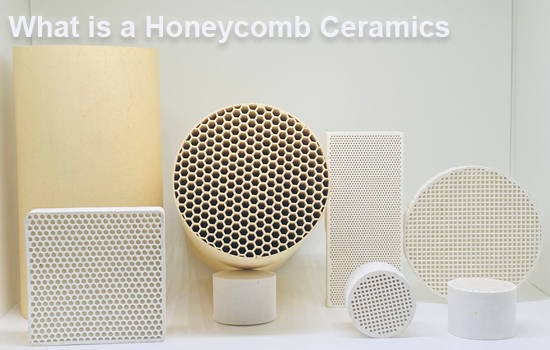Last Updated on 12 мая, 2023 by You Ling
In recent years, the demand for environmentally friendly and efficient materials has been growing across various industries. One such innovative material that has captured the attention of researchers and engineers is honeycomb ceramics. This material boasts a unique honeycomb structure, offering numerous advantages and versatility in its applications. The following article provides an in-depth exploration of honeycomb ceramics, discussing their types, characteristics, chemical composition, preparation process, and the multitude of applications in industries such as automotive, chemical, electric power, and more. By understanding the potential of honeycomb ceramics, we can better harness their benefits and pave the way for a more sustainable and efficient future across multiple sectors. 1、What is a Honeycomb Ceramics Honeycomb ceramics is a novel ceramic product with a structure resembling a honeycomb shape. It was initially used in small car exhaust purification, and now it is widely used in industries such as chemical, electric power, metallurgy, petroleum, electronics, and machinery, with increasingly broader applications and promising prospects. Honeycomb ceramics can be made from a variety of materials, mainly including cordierite, mullite, alumina titanate, activated carbon, silicon carbide, activated alumina, zirconia, silicon nitride, and composite matrices. 2、Types of Honeycomb Ceramics
Honeycomb ceramics can be divided into four major categories based on their uses: heat storage bodies, packing materials, catalyst carriers, and filter materials.
Honeycomb ceramic heat storage bodies have a heat capacity of over 1000 kJ/kg, with the highest operating temperature of at least 1700℃. They can save more than 40% fuel in furnaces such as heating furnaces, baking ovens, homogenizing furnaces, and cracking furnaces, increase production by more than 15%, and lower the temperature of the emitted smoke to below 150℃.
Honeycomb ceramic packing materials have a larger specific surface area and better strength than other shaped packing materials, resulting in more uniform gas-liquid distribution, reduced bed resistance, better performance, and extended service life. They are used as packing materials in the petrochemical, pharmaceutical, and fine chemical industries with great success.
Honeycomb ceramics are particularly advantageous when used as catalysts. Using honeycomb ceramic materials as carriers and adopting unique coating materials, they are prepared with precious metals, rare earth metals, and transition metals, resulting in high catalytic activity, excellent thermal stability, long service life, and high strength.
2、Types of Honeycomb Ceramics
Honeycomb ceramics can be divided into four major categories based on their uses: heat storage bodies, packing materials, catalyst carriers, and filter materials.
Honeycomb ceramic heat storage bodies have a heat capacity of over 1000 kJ/kg, with the highest operating temperature of at least 1700℃. They can save more than 40% fuel in furnaces such as heating furnaces, baking ovens, homogenizing furnaces, and cracking furnaces, increase production by more than 15%, and lower the temperature of the emitted smoke to below 150℃.
Honeycomb ceramic packing materials have a larger specific surface area and better strength than other shaped packing materials, resulting in more uniform gas-liquid distribution, reduced bed resistance, better performance, and extended service life. They are used as packing materials in the petrochemical, pharmaceutical, and fine chemical industries with great success.
Honeycomb ceramics are particularly advantageous when used as catalysts. Using honeycomb ceramic materials as carriers and adopting unique coating materials, they are prepared with precious metals, rare earth metals, and transition metals, resulting in high catalytic activity, excellent thermal stability, long service life, and high strength.
 3、Characteristics of Honeycomb Ceramics
High strength, high-temperature resistance, corrosion resistance, and wear resistance make honeycomb ceramics suitable for various environmental protection fields. Some properties include:
High surface area
High porosity and uniform pore diameter
Low pressure drop
Low thermal expansion coefficient
High thermal shock and vibration resistance
High resistance to chemical corrosion (anti-acid ≥99.8%)
High compressive strength
4、Chemical Composition of Honeycomb Ceramics
Ceramic honeycombs are typically made from kaolin, talc, aluminum powder, and clay. Nowadays, by adding zeolite and other refractory materials, other properties can be obtained for these materials.
Structural materials (MOC):
Cordierite
Cordierite chemical composition:
Alumina: 35.2±1.5%
Silica: 50.9±1.5%
Magnesia: 13.9±1.5%
3、Characteristics of Honeycomb Ceramics
High strength, high-temperature resistance, corrosion resistance, and wear resistance make honeycomb ceramics suitable for various environmental protection fields. Some properties include:
High surface area
High porosity and uniform pore diameter
Low pressure drop
Low thermal expansion coefficient
High thermal shock and vibration resistance
High resistance to chemical corrosion (anti-acid ≥99.8%)
High compressive strength
4、Chemical Composition of Honeycomb Ceramics
Ceramic honeycombs are typically made from kaolin, talc, aluminum powder, and clay. Nowadays, by adding zeolite and other refractory materials, other properties can be obtained for these materials.
Structural materials (MOC):
Cordierite
Cordierite chemical composition:
Alumina: 35.2±1.5%
Silica: 50.9±1.5%
Magnesia: 13.9±1.5%
 5、Preparation Process of Honeycomb Ceramics
Honeycomb ceramics can be made from a variety of materials. The primary materials include cordierite, mullite, aluminum titanate, activated carbon, silicon carbide, activated alumina, zirconia, silicon nitride, and composite substrates of cordierite-mullite and cordierite-aluminum titanate.
After shaping activated carbon powder or granules into a honeycomb ceramic structure, the purification and wastewater treatment capacity is significantly improved, particularly in the pharmaceutical industry for the removal of impurities, dehydration, and decolorization of antibiotics, hormones, vitamins, nucleic acid injections, and various other injections and drugs. As honeycomb ceramics are formed through extrusion, various additives must be added to the main raw materials to enhance the plasticity and fluidity of the clay body. These additives primarily include binders, plasticizers, deflocculants, lubricants, and wetting agents. Moreover, there are also water retention agents, chelating agents, antistatic agents, colloidal protectants, and surfactants. Currently, starch, carboxymethyl cellulose, and polyvinyl alcohol are widely used as binders, tung oil and stearic acid as lubricants, and glycerin as a plasticizer.
5、Preparation Process of Honeycomb Ceramics
Honeycomb ceramics can be made from a variety of materials. The primary materials include cordierite, mullite, aluminum titanate, activated carbon, silicon carbide, activated alumina, zirconia, silicon nitride, and composite substrates of cordierite-mullite and cordierite-aluminum titanate.
After shaping activated carbon powder or granules into a honeycomb ceramic structure, the purification and wastewater treatment capacity is significantly improved, particularly in the pharmaceutical industry for the removal of impurities, dehydration, and decolorization of antibiotics, hormones, vitamins, nucleic acid injections, and various other injections and drugs. As honeycomb ceramics are formed through extrusion, various additives must be added to the main raw materials to enhance the plasticity and fluidity of the clay body. These additives primarily include binders, plasticizers, deflocculants, lubricants, and wetting agents. Moreover, there are also water retention agents, chelating agents, antistatic agents, colloidal protectants, and surfactants. Currently, starch, carboxymethyl cellulose, and polyvinyl alcohol are widely used as binders, tung oil and stearic acid as lubricants, and glycerin as a plasticizer.
 6、Applications of Honeycomb Ceramics
Catalyst Carriers
When used as catalyst carriers, honeycomb ceramics are primarily employed in automotive exhaust purification, boiler flue gas denitration (NOx), industrial exhaust odor removal, and the elimination of toxic and harmful gases. Honeycomb ceramic catalyst carriers used in automotive exhaust purification are mainly cordierite honeycomb ceramics coated with γ-Al2O3.
Refractory Kiln Furniture
Extruded honeycomb ceramic kiln furniture is 60%-75% lighter in weight than traditional kiln furniture, allowing for rapid heat transfer and fast firing. Using honeycomb ceramics as supports for firing ferrites or other electronic ceramics helps improve the performance of the products.
Wall-flow Filters
Thin-walled, porous honeycomb ceramics can be used to filter and purify carbon particles in diesel engine exhaust gases (at around 500℃).
7、In conclusion, honeycomb ceramics are versatile and innovative materials with a unique honeycomb structure that offers various advantages. They are used in a wide range of industries, including automotive, chemical, electric power, metallurgy, petroleum, electronics, and machinery. Their excellent properties, such as high strength, high-temperature resistance, corrosion resistance, and wear resistance, make them suitable for various applications, including heat storage bodies, packing materials, catalyst carriers, and filter materials. With continuous advancements in material science and the growing demand for environmentally friendly and efficient materials, honeycomb ceramics will likely play an increasingly important role in various industries, promising a bright future for their development and applications.
6、Applications of Honeycomb Ceramics
Catalyst Carriers
When used as catalyst carriers, honeycomb ceramics are primarily employed in automotive exhaust purification, boiler flue gas denitration (NOx), industrial exhaust odor removal, and the elimination of toxic and harmful gases. Honeycomb ceramic catalyst carriers used in automotive exhaust purification are mainly cordierite honeycomb ceramics coated with γ-Al2O3.
Refractory Kiln Furniture
Extruded honeycomb ceramic kiln furniture is 60%-75% lighter in weight than traditional kiln furniture, allowing for rapid heat transfer and fast firing. Using honeycomb ceramics as supports for firing ferrites or other electronic ceramics helps improve the performance of the products.
Wall-flow Filters
Thin-walled, porous honeycomb ceramics can be used to filter and purify carbon particles in diesel engine exhaust gases (at around 500℃).
7、In conclusion, honeycomb ceramics are versatile and innovative materials with a unique honeycomb structure that offers various advantages. They are used in a wide range of industries, including automotive, chemical, electric power, metallurgy, petroleum, electronics, and machinery. Their excellent properties, such as high strength, high-temperature resistance, corrosion resistance, and wear resistance, make them suitable for various applications, including heat storage bodies, packing materials, catalyst carriers, and filter materials. With continuous advancements in material science and the growing demand for environmentally friendly and efficient materials, honeycomb ceramics will likely play an increasingly important role in various industries, promising a bright future for their development and applications.




